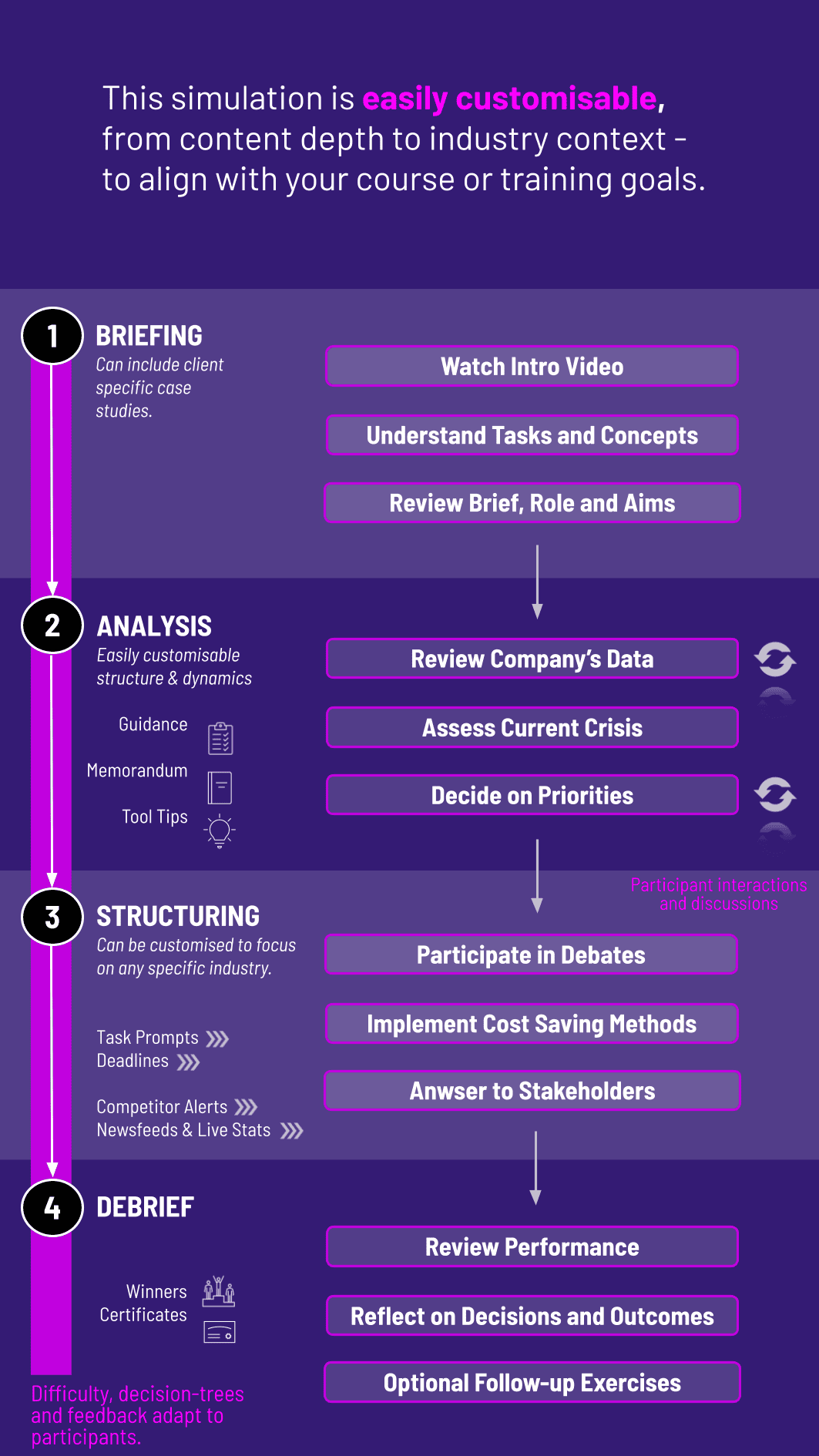
In this hands-on Leadership in Financial Crises Simulation, participants act as senior executives navigating high-stakes decisions, stakeholder pressure, and ethical dilemmas amid financial turmoil, strategic uncertainty, and public scrutiny.
Crisis leadership and decision-making under pressure
Financial distress and turnaround strategies
Internal and external communication in high-stakes settings
Stakeholder prioritization: investors, regulators, employees
Ethical and reputational risk management
Liquidity management and cost-cutting
Strategic agility in unpredictable environments
Public confidence and media response
Psychological safety and team morale
Scenario planning and contingency frameworks


Assess liquidity, solvency, and operational risks
Decide which areas to cut, save, or double down on
Negotiate with lenders, regulators, or activist investors
Deliver bad news or reframe the narrative
Manage internal tensions and board expectations
Justify difficult trade-offs in front of critical audiences
By the end of the simulation, participants will be able to:
Lead with clarity during ambiguous and volatile conditions
Prioritize strategic goals while managing public perception
Make defensible financial and operational decisions under pressure
Communicate transparently while maintaining leadership presence
Manage stakeholder relationships in crisis scenarios
Balance ethical responsibility with business needs
Structure decision-making frameworks under stress
Respond to feedback and adapt with agility
Collaborate under high stakes in cross-functional teams
Reflect on the personal toll and leadership maturity required in crises
The simulation’s flexible structure ensures that these objectives can be calibrated to match the depth, duration, and focus areas of each program, whether in higher education or corporate learning.
This simulation is suitable for business schools, executive programs, crisis management workshops, and senior leadership training. Each round reflects an evolving phase of the crisis - from sudden onset to long-term recovery.
1. Receive a Brief: Each round begins with a new crisis development, key facts, stakeholder reactions, and urgent objectives. Participants quickly assess where things stand.
2. Analyse and Prioritise: Participants review financials, sentiment data, internal reports, and media snippets to define their approach - deciding what to act on and what to communicate.
3. Make Critical Leadership Decisions: They choose cost cuts, investor responses, media statements, and stakeholder strategies - often with no perfect option available.
4. Collaborate or Challenge (Optional Team Format): In group settings, participants debate decisions, role-play boardroom conversations, or divide tasks across CEO/CFO/Comms teams.
5. Communicate and Reflect: Each team shares a memo, press release, or board update explaining their response. Real-time feedback highlights trade-offs and stakeholder reactions.
6. Move to the Next Round: Each round reveals new consequences - positive or negative - and participants must adapt their leadership strategy accordingly.
Do I need prior finance knowledge? No. Key financial terms are introduced during the simulation. The focus is on leadership, not technical accounting.
Can this be run for teams or individuals? Both. Team formats allow role-playing and collaboration; individual formats highlight personal leadership under pressure.
Is this based on real events? Yes. Scenarios are inspired by real corporate or systemic crises - but anonymized and adjusted for learning.
What industries are covered? The simulation can be tailored to banking, corporate, public sector, or cross-industry crisis cases.
Is media and PR response part of it? Yes. Participants must often write public statements or internal memos.
Does this work for online delivery? Yes. It’s flexible for in-person, hybrid, or fully remote formats.
How long does the simulation take? It can run as a short 2-hour exercise or across a multi-day training session.
Can this be run in a boardroom setting? Absolutely. It’s designed to feel like a high-level crisis room.
Improvement in financial performance across rounds
Strategic alignment of cost-cuts and investments
Communication clarity in crisis contexts
Ethical decision-making and stakeholder sensitivity
Learning agility and responsiveness to feedback
Peer and self-assessments to capture collaboration and iteration
You can also include memo writing and debrief presentations as part of the assessment structure. Additionally, you can also add a built-in peer and self-assessment tool to see how participants rate themselves. This flexibility allows the simulation to be easily integrated by professors as graded courses at universities and by HR at assessment centres at companies.
Join this 20-minute webinar, followed by a Q&A session, to immerse yourself in the simulation.
or
Book a 15-minute Zoom demo with one of our experts to explore how the simulation can benefit you.